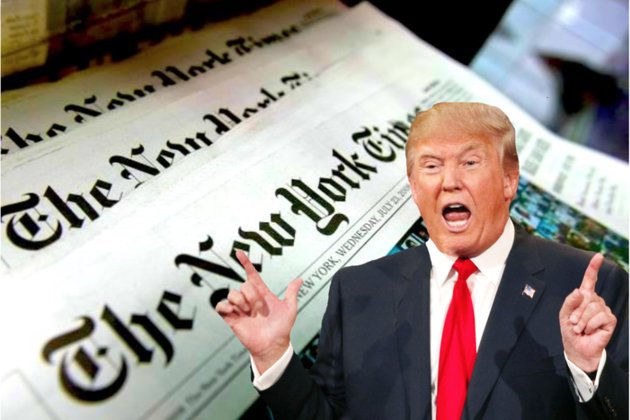2LT International News
Trump touts meeting with NYT publisher, then distorts facts
Jul 30, 2018
NEW YORK, U.S. – Nine days after holding an off-the-record, private meeting with the New York Times Publisher A.G. Sulzberger at the White House – the U.S. President decided to make the once-private meeting public on Sunday.
Taking to Twitter on Sunday, Trump decided to disclose details of his off-the-record meeting with Sulzberger.
Trump, who is a regular Times reader, declared on Twitter that he had talked with Sulzberger, one of most powerful media executives in the country, about “the vast amounts of Fake News being put out by the media.”
The U.S. President tweeted, “Had a very good and interesting meeting at the White House with A.G. Sulzberger, Publisher of the New York Times. Spent much time talking about the vast amounts of Fake News being put out by the media & how that Fake News has morphed into phrase, ‘Enemy of the People.’ Sad!”
However, Trump’s tweet not only sent the Times scrambling to offer its own version of events, but also put the publication in a situation where it would have to explain in detail what happened at the meeting.
Trump’s retelling of the off-the-record conversation was immediately disputed by the NYT publisher, who then released an elaborate statement of discussions held during the July 20 meeting.
In a statement released by the Times about the White House meeting held nine days back, Sulzberger first argued that Trump’s decision to discuss the meeting publicly nullified their off-the-record agreement.
He said that his main purpose for accepting the meeting was to “raise concerns about the president’s deeply troubling anti-press rhetoric.”
He then explained in the statement, “I told the president directly that I thought that his language was not just divisive but increasingly dangerous. I warned that this inflammatory language is contributing to a rise in threats against journalists and will lead to violence.”
Sulzberger added, “I repeatedly stressed that this is particularly true abroad, where the president’s rhetoric is being used by some regimes to justify sweeping crackdowns on journalists. I warned that it was putting lives at risk, that it was undermining the democratic ideals of our nation, and that it was eroding one of our country’s greatest exports: a commitment to free speech and a free press.”
Sulzberger also pointed out in his statement that he told Trump that previous presidents have taken issue with the coverage of their administration but that he should reconsider his broader anti-press diatribes.
Explaining further, Sulzberger said, “I made clear repeatedly that I was not asking for him to soften his attacks on The Times if he felt our coverage was unfair. Instead, I implored him to reconsider his broader attacks on journalism, which I believe are dangerous and harmful to our country.”
According to The New York Times, Sulzberger had gone to the White House accompanied by James Bennet, who oversees the editorial page of The Times.
The publication said in its statement, “Mr. Trump’s aides requested that the meeting be off the record, which has also been the practice for such meetings in the past. But with Mr. Trump’s tweet this morning, he has put the meeting on the record, so A.G. has decided to respond to the president’s characterization of their conversation, based on detailed notes A.G. and James took.”
After Times put out its version of events, Trump again fired off a series of tweets about the media and said that the New York Times and Washington Post “do nothing but write bad stories.”
Trump wrote, “When the media-driven insane by their Trump Derangement Syndrome – reveals internal deliberations of our government, it truly puts the lives of many, not just journalists, at risk! Very unpatriotic! I will not allow our great country to be sold out by anti-Trump haters in the…dying newspaper industry. Freedom of the press also comes with a responsibility to report the news…”
Last week, Trump and his administration continued to keep up attacks on the media – with Trump bashing the news media during a speech in Missouri and then his White House barring a CNN reporter from covering an event.
Trump said in Missouri that what the media is covering is “not what’s happening” and he urged his supporters not to believe the news.
Trump said during the speech, “Don’t believe the crap you see from these people — the fake news.”
Then, around the same time, a CNN reporter was barred from covering an event at the White House.
The decision prompted widespread outrage from journalists across the country.
It now appears that Trump’s attacks on the media last week came after he had met Sulzberger and came despite the NYT publisher’s concerns he claims to have raised with the U.S. President.
Soon after the row exploded online, Sulzberger’s meeting with the president was attacked by Times’ critics, who pointed out that the publication had given Trump an opportunity to use the meeting to amplify his attacks on the press.
Neera Tanden, president of the Center for American Progress, a liberal group, tweeted, “The media always gets played by Trump. Always. Going to the meeting, The Times was going to get played. His tweet after the meeting will do more damage than anything gained by going to the meeting. Do you think your pleas will be heard?”







